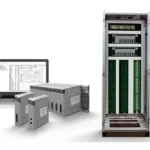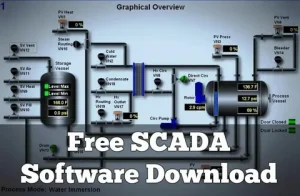Introduction:
An electric motor is driven by a variable frequency drive (VFD), a motor controller, by altering the frequency and voltage provided to the electric motor. Variable speed drives (VFDs) are also referred to as adjustable speed drives (ASDs), variable frequency drives (AFDs), AC drives (drives), micro drives, and inverters. The speed of the motor and frequency are directly proportional. Suppose a full-speed electric motor is unnecessary for an application. In that case, the variable frequency drive (VFD) can reduce the frequency and voltage to meet the needs of the electric motor’s load. The VFD can quickly increase or decrease the motor speed to match the speed requirement as the application’s speed requirements change. Visit the Technical Files website to download any Software.
Working Principal of VFD:
Before the VFD can operate, a rectifier converts the AC power source into DC power, which commonly uses transistors or diodes. A capacitor is then used to store this DC energy. Then, the AC signal with variable frequency and voltage is created by inverting the DC power. IGBTs or other semiconductor components are used to accomplish this. The VFD’s control unit continuously modifies the output’s frequency and voltage to achieve the desired motor speed. This alters the load’s mechanical output.
Benefits of VFD:
- Soft Starting: VFDs allow motors to start and stop gradually, preventing unexpected voltage and current spikes. This is crucial in applications like elevators and conveyor systems where preventing sudden movements or shocks is essential.
- Direct-on-line starting is a component of traditional motor control techniques, which places a heavy mechanical burden on connected systems and motors. By gradually increasing motor speed, VFDs reduce mechanical wear and tear and alleviate this tension.
- Energy consumption optimization is one of the most essential benefits of VFDs. VFDs minimize the need to operate motors constantly at full speed by regulating the speed of the motor in accordance with the real load requirements. As a result, there are significant energy savings, decreased utility costs, and a smaller carbon footprint.
Applications of VFD:
- VFDs are essential for controlling mud pumps and draw works during drilling operations. They guarantee accurate and effective drilling while reducing equipment wear.
- VFDs are utilized in the agricultural industry to regulate irrigation pumps, grain drills, and other machinery to optimize resource use and boost crop yields.
- VFDs are a mainstay in manufacturing facilities because they enable accurate control of conveyors, mixers, compressors, and other machinery. Energy use is decreased due to this control, and product quality is raised.
Challenges & Considerations
- VFDs may cause the electrical system to experience harmonic distortion, which may call for further measures like harmonic filters to reduce.
- VFDs produce heat while operating, so additional cooling systems can be required, especially in cramped or hot settings.
- VFDs need routine maintenance like any other electronic gear to keep working at their best.
Conclusion
Variable Frequency Drives (VFDs), which provide precise control, energy efficiency, and longer equipment lifespan. That have entirely changed the industrial automation scene. Their uses are widespread, ranging from manufacturing and agriculture to alternative energy and HVAC systems. As technology develops, VFDs will become ever more important in determining the direction of automation.








